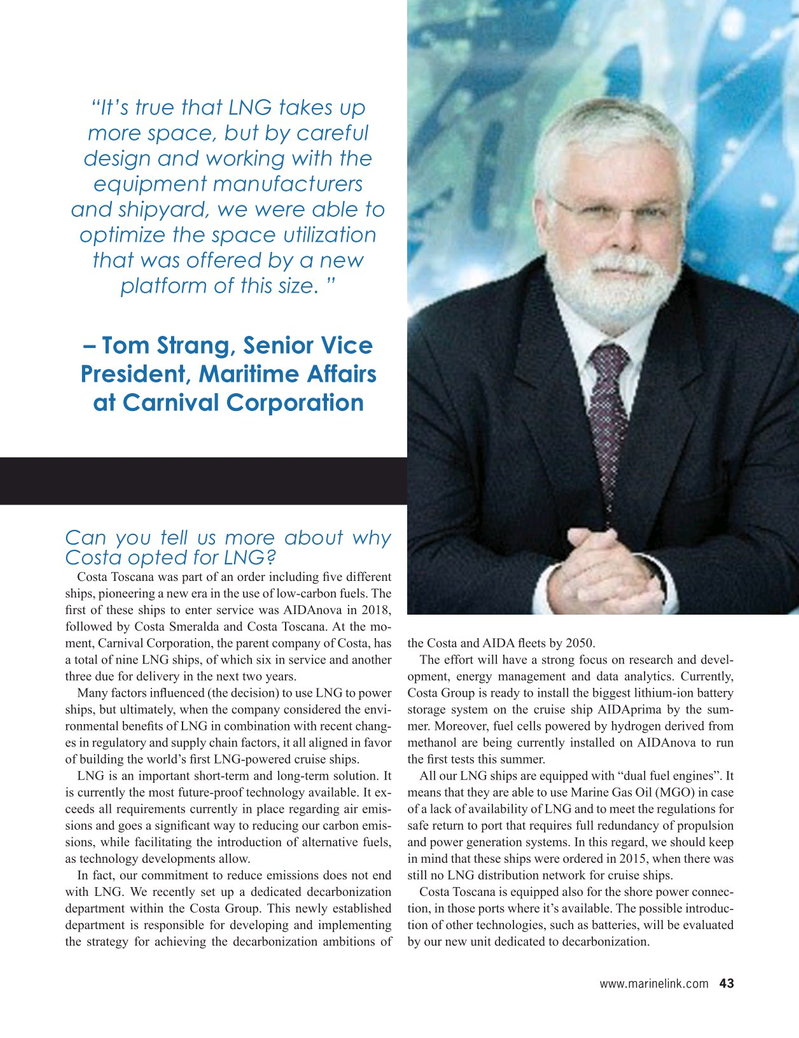
Page 43: of Maritime Reporter Magazine (September 2022)
The Marine Design Edition
Read this page in Pdf, Flash or Html5 edition of September 2022 Maritime Reporter Magazine
“It’s true that LNG takes up more space, but by careful design and working with the equipment manufacturers and shipyard, we were able to optimize the space utilization that was offered by a new platform of this size. ” – Tom Strang, Senior Vice
President, Maritime Affairs at Carnival Corporation
Can you tell us more about why
Costa opted for LNG?
Costa Toscana was part of an order including ? ve different ships, pioneering a new era in the use of low-carbon fuels. The ? rst of these ships to enter service was AIDAnova in 2018, followed by Costa Smeralda and Costa Toscana. At the mo- ment, Carnival Corporation, the parent company of Costa, has the Costa and AIDA ? eets by 2050. a total of nine LNG ships, of which six in service and another The effort will have a strong focus on research and devel- three due for delivery in the next two years. opment, energy management and data analytics. Currently,
Many factors in? uenced (the decision) to use LNG to power Costa Group is ready to install the biggest lithium-ion battery ships, but ultimately, when the company considered the envi- storage system on the cruise ship AIDAprima by the sum- ronmental bene? ts of LNG in combination with recent chang- mer. Moreover, fuel cells powered by hydrogen derived from es in regulatory and supply chain factors, it all aligned in favor methanol are being currently installed on AIDAnova to run of building the world’s ? rst LNG-powered cruise ships. the ? rst tests this summer.
LNG is an important short-term and long-term solution. It All our LNG ships are equipped with “dual fuel engines”. It is currently the most future-proof technology available. It ex- means that they are able to use Marine Gas Oil (MGO) in case ceeds all requirements currently in place regarding air emis- of a lack of availability of LNG and to meet the regulations for sions and goes a signi? cant way to reducing our carbon emis- safe return to port that requires full redundancy of propulsion sions, while facilitating the introduction of alternative fuels, and power generation systems. In this regard, we should keep as technology developments allow. in mind that these ships were ordered in 2015, when there was
In fact, our commitment to reduce emissions does not end still no LNG distribution network for cruise ships.
with LNG. We recently set up a dedicated decarbonization Costa Toscana is equipped also for the shore power connec- department within the Costa Group. This newly established tion, in those ports where it’s available. The possible introduc- department is responsible for developing and implementing tion of other technologies, such as batteries, will be evaluated the strategy for achieving the decarbonization ambitions of by our new unit dedicated to decarbonization.
www.marinelink.com 43
MR #9 (34-49).indd 43 9/5/2022 6:23:34 PM

 42
42

 44
44
